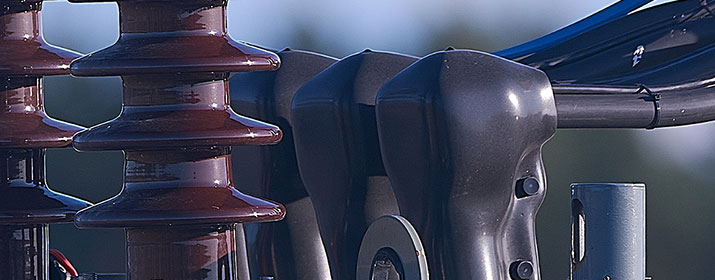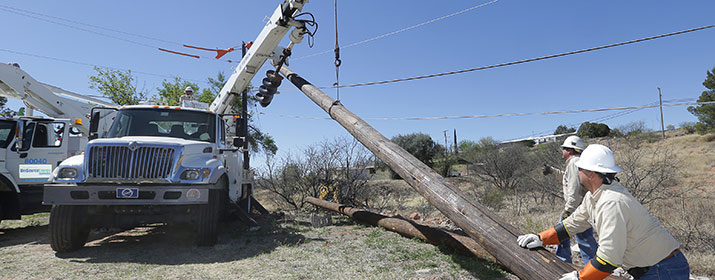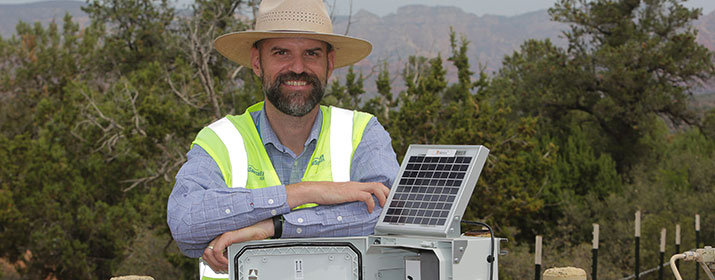
Because our electric grid covers 8,056 square miles, maintaining it is an enormous undertaking.
UniSource’s electrical system is an intricate network of power lines, substations, transformers, circuits and utility poles. Since the beginning of 2015, we’ve invested more than $319 million to maintain and improve our electric transmission and distribution systems to support system integrity and keep our equipment in top working order.
“We work yearlong to ensure all the equipment in our system is able to withstand extreme heat, monsoon storms and increasing peak energy demands,” said Terry Nay, TEP’s Vice President of Field Operations. “Our field operations employees focus their efforts on testing, maintaining, upgrading and expanding the equipment that is essential to powering homes and businesses.”
Here’s what we do to maintain the major components of our electrical system to ensure the safe, reliable delivery of energy to more than 100,000 electric customers in Mohave and Santa Cruz Counties.
Generating Power
UniSource’s largest generating resource is Unit 3 at the Gila River Power Station, a 550-megawatt (MW) natural gas-fired unit that was purchased with sister company Tucson Electric Power in 2014. Our 137-MW share of the unit’s output provides most of the energy used by our electric customers.
To ensure Gila River and all our generating resources operate at peak performance, UniSource uses a Centralized Maintenance Management System along with recommendations from manufacturers and vendors to schedule and track preventive, corrective and predictive maintenance.
Keeping the Power Flowing
UniSource’s 344 miles of transmission lines span remote Arizona forests and deserts, carrying higher voltage electricity long distances from generating stations into Mohave and Santa Cruz Counties. They’re critical to maintain because any fault along the way could cause a widespread outage.
UniSource regularly inspects our 138 kilovolt (kV) transmission lines from the ground, checking insulators, guy wires, wood poles and other equipment for signs of wear or damage. We also conduct annual aerial inspections by helicopter to check the condition of our 69kV transmission lines and equipment. Our inspectors also look for signs of sabotage or foreign objects caught in the lines or structures as well as encroachment by vegetation.
UniSource also uses customized smart inspection and mapping software to manage inspections and maintenance of our 138kV structures based on their voltage. Needed repairs are prioritized by severity of the defect and their impact on system safety and reliability.
“Anything needing repair is assigned a priority level with highest priority items addressed immediately.” said Roberto Guevara, Director of Operations and Operational Excellence. “Less critical items are sent to our engineering and planning departments so that they can be added to the schedule and grouped by location for the greatest efficiency in scheduling repairs.”
Checking Distribution Lines and Cables
UniSource’s distribution system consists of more than 3,130 miles of overhead lines and 630 miles of underground cables that carry lower voltage electricity from our substations through circuits to customers. Crews visually inspect the condition of lines, crossarms and pad-mounted equipment.
Engineers also perform an annual critical circuit analysis to evaluate our most problematic circuits for their reliability based on outage data, demand, capacity, age and load. That information is used to assign each circuit a rating, which determines needed maintenance and improvements and how often it should be checked by journeymen linemen during their patrols. They also assess the insulators, guy wires, poles, cross arms, wires and other equipment and evaluate nearby vegetation growth. The repair or replacement of equipment found to be responsible for recurring outages is prioritized to improve reliability.
Long rural distribution lines and transmission lines that are difficult to access due to terrain or distance are inspected aerially by helicopter annually. This helps inspectors get a bird’s eye view of equipment and structures and note any needed repairs or improvements.
Tending to Substations and Transformers
UniSource’s 41 substations – which house transformers, switches and circuit breakers – serve as an important link between our transmission and distribution systems. Substation transformers “step down” high voltage electricity from transmission lines to lower voltages for distribution through circuits into neighborhoods. Each substation transformer serves about 2,000 customers. They can take up to two years to procure and cost about $1.4 million each.
To evaluate the performance of our substations, UniSource assesses the condition of transformers using a combination of time-based inspections, online monitors and testing recommended by the manufacturer. Engineers evaluate data on the unit’s oil condition, infrared scans, maintenance schedule and reliability history to determine a repair or replacement schedule, which folds into our five-year substation maintenance plan.
Some of our newer substations use telemetry to remotely monitor and detect faults and provide an alarm to help pinpoint problems. If a circuit breaker needs to be repaired or replaced, UniSource uses spares we have on hand.
In addition to our installed substations, UniSource also maintains mobile substations and transformers. These are used during extended outages, times of high energy usage or when we’re making upgrades and improvements to equipment.
“In addition to all our regular maintenance, there’s a lot of proactive work being done by our engineers to reinforce the integrity of our system,” Guevara said. “They are constantly identifying heavier loads to circuits that are driven by hotter summers, new growth and development. As they reach their capacity, we may need to add a new substation or upgrade our system.”
Trimming Back Vegetation
Maintaining reliability requires vigilant vegetation management. Trees and plants that encroach on our lines and equipment must be trimmed back to ensure service reliability. Inspectors use mobile technology to track historical data to identify areas of higher growth patterns.
Trees along transmission corridors, roadways and utility easements are trimmed every five years to comply with mandatory North American Electric Reliability standards. Keeping our power lines away from vegetation helps reduce potential fuel sources for wildfires and prevent power outages.
“All of the steps we take to maintain and improve the equipment in our grid require enormous resources and effort,” said Nay. “We are committed to ensuring the integrity of our electrical system because we know our customers count on us. We’re proud of our employees’ dedication to the communities we serve.”






